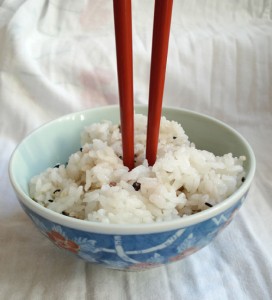I’ll never forget the first time my Grandma joined me and my folks at our favorite local sushi bar . Our favorite chef, Kimura-san, had become a friend, and as we settled in to his warm welcome and towels to wipe our hands, our individual sushi plates with fresh ginger and square dollops of wasabi were placed before us.
This was my grandmother’s first sushi experience, and she promptly picked up the piece of wasabi and plopped it in her mouth exclaiming, “Oh, I love avocado!” Before we could warn her, her face turned red and tears came to her eyes as the hot mustard overtook her palette. A few minutes and a tall glass of water later, we all had a good laugh, and the worried look on Kimura-san’s face gave way to his characteristic grin.
Like every person who didn’t grow up eating sushi, my grandma had experienced her first sushi faux pas.
Sushi, perhaps the most visible example of Japanese cuisine in most countries, has more than 1,000 years of history and tradition, and its popularity here in California is undeniable. But like many types of cuisine, sushi has conventions and etiquette all its own, which should be observed especially when dining in a restaurant.
Many years after the experience with my grandma, I had the good fortune to spend a few months in Japan, where I learned (sometimes the hard way) the finer points of eating sushi. My own major faux pas came as I was dining with my hosts at a lovely sushi bar in Tokyo.
As we ate, I decided to take a break from the delicious assortment before me. Not wanting to set them on the table, I casually stuck my chop sticks upright in my rice bowl – upon which the entire table went deathly silent and everyone looked at me in horror.

I quickly learned from the young lady on my right that this is a big no-no because it’s the way a bowl of rice is offered to the spirit of a dead person, at their deathbed or in front of their photograph on the household Buddhist altar. Crossing your chopsticks on the table or over food is also considered to be a no-no for the same reason, but the upright-in-rice thing is the worst.
If you haven’t already experienced your own sushi faux pas, here are a few tips to help you avoid any in the future.
- Never pass food to someone using chopsticks. This act parallels passing cremated bones of a deceased relative at a Japanese funeral. If you must share food, pass the plate so that the person can pick from it instead.
- If you take food from a shared plate (such as in the above situation), use the reverse ends of your chopsticks rather than the ends that go in your mouth.
- Never bite into a piece of sushi and then replace the other half on your plate. Once you have picked a piece up you should eat all of it, bulging cheeks and all. This can be awkward on a first date or when dining with your boss, but the rule still holds.
- When not using your chopsticks, you should place them in front of you, parallel to the edge of the sushi bar, with the narrow ends in the provided hashi oki (small chopstick holder); never place them directly on the bar, and as aforementioned, never stick them straight up in your rice bowl.
- Never leave rice after a meal. Leaving any kind of food is considered rude, but leaving rice is especially so. (This is a tough rule for those who limit carbs or are full with a half a bowl. Truth be told I often break this rule.)
- Never expect the chef to handle money; another employee will settle the bill for you. People who handle the food never touch the money.
- Do not ask for knives. This would imply that the food is so tough it can’t be properly eaten without them.
- Please. Don’t make wasabi soup with your soy sauce! Sushi Chefs cringe at this spectacle that we Americans often make. Wasabi paralyzes your palette and will hide the subtle flavors of fish eaten raw. Dab the wasabi on the food you wish to flavor it with, but avoid mixing it with your soy sauce.
And finally, most Westerners eat sushi by dipping it rice-side-down into the soy, soaking the rice, then wonder why the sushi disintegrates on its way from the soy to their mouth, leaving annoying little flecks of soy-stained rice all over the bar and their clothing. Sushi connoisseurs rarely have this problem, because they know that the purpose of the soy is not to flavor the rice, but the fish. As such, the sushi should be dipped rice-side-up in the soy and then carried to the mouth.
Observe these basic rules next time you visit your favorite sushi bar and when the chef exclaims, “Arigatou gozaimasu!” as you leave, it will take on a whole new meaning.
Columnist Lynn Selich resides in Newport Beach. She can be reached via www.LynnSelich.blogspot.com.




